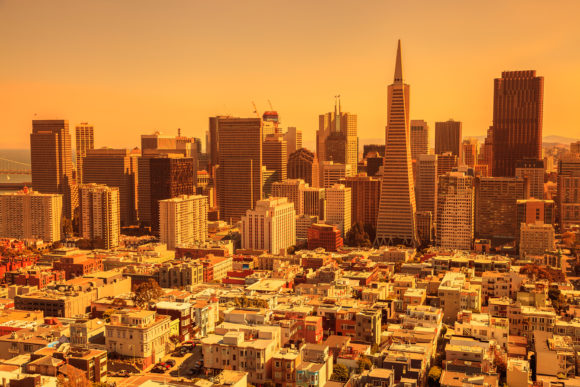Residents of fire-ravaged Western states, and an entire world of observers looking on in horror, have asked themselves, “How can this be happening?”
As fire last week taunted Paradise, California, destroyed in the 2018 Camp Fire, many others have found themselves asking a related, but much more complicated question: How can this be happening again?”
California burns. Everybody knows that. But why does it seem like forests are igniting more often?
“Are these landscapes burning more frequently?” said Jon Keeley, a U.S. Geological Survey research scientist. “The answer is absolutely yes.”
But beyond the aggregate numbers, that big, central question splinters into a forest of smaller ones whose answers span the latitude, longitude, and altitude of the American West. California, the focus of Keeley’s work, has its own galaxy of fire environments.
Rate of Fires
To know whether fires are returning to parts of the state faster than they have before first requires some sense of the long-term “normal.” Scientists have found that mountainous and forested northern California environments experience fires much less frequently than they used to, while southern parts of the state see more of them. This passes a common-sense check, since old, slow-growing forests, as in the North, seem harder to burn down than small vegetation dried out by high-summer temperatures that occur in the South.
Researchers have assembled maps of California that show how the rate of fires has changed between the time before mass human settlement to the 20th century.
The blue northern areas see fewer fires in part because of a century-long effort to stop them from happening. Until relatively recently, these less populated, more remote areas experienced blazes that were largely caused by dry lightning. That’s what happened in August, and something like it can happen every decade or so, Keeley said. The last major episode occurred in 2008. The Southern coastal areas don’t receive the same lightning. They are, however, covered with lower-lying brush and support a larger human population — which tends to start more fires, even though the same fire policies are in place there as in the North.
Those are just the long-term trends. How to understand the dramatic speed of return of California wildfires in recent years requires a simplification of the many variables that cause fires — autumn winds, lightning, drought, land-use, and, yes, the wood or “fuel” backlog from a century of fire suppression and climate change.
Keeley has offered a way to simplify and clarify the factors driving the increase in fires around the state. He explains the rise of large 21st century California wildfires by comparing those that are driven by wind with those that are “fuel”-driven. This framework suggests that while it’s brought up frequently in public discussions, the build-up of forest fuel is only one factor in northern fires; others include land-use and development trends and past timber-harvesting practices. That said, a resumption in the forestry practice of managed burning in higher and northern areas would help. To the south, autumn winds turn human actions—power-line failures and arson—into conflagrations, and fuel is less of a factor. Whatever can burn will.
Moisture and Dryness
Erin Hanan, an assistant professor at University of Nevada, Reno, offers another two-part model. In some places, historically at least, there’s too much moisture for fires to grow. As some northern areas filled with fuel dry out under rising temperatures and longer fire seasons, however, moist climate is less of an impediment to fire. In contrast to these areas, she writes, there are also very dry, “fuel-limited areas,” where everything burns easily. Many places fall in-between these extremes.
Against the backdrop of all these factors—California’s fire-prone geography and ecosystems, the Santa Ana and North winds, the century of fire suppression, land-development closer to forests, human activity and the overall growth in California’s population—climate change progresses. Which of these factors is responsible for the current conflagrations? All of them, Keeley said. The entire wildfire system is activated.
Not only are these factors never far from Keeley’s research, they’re not far from his house.
An estimated 140 million trees died in the last decade during California’s drought, itself worsened by climate change. “Right after this occurred, I would go out on my porch and look up at the mountain beside us and it’s just covered with dead trees,” he said on Tuesday from his home in Three Rivers, California. “Now we’re paying for that because there’s a big fire that’s threatening evacuation of our house.”
Photo: Smoky orange sky of San Francisco skyline during California fires September 2020.
Topics California Wildfire
Was this article valuable?
Here are more articles you may enjoy.



 CEOs on Guard as Trump Rattles Companies With Series of Edicts
CEOs on Guard as Trump Rattles Companies With Series of Edicts  Florida Lawmakers Ready for Another Shot at Litigation Funding Limits
Florida Lawmakers Ready for Another Shot at Litigation Funding Limits  Alliant Latest to Sue Howden US Over Alleged ‘Smash-and-Grab’ Poaching
Alliant Latest to Sue Howden US Over Alleged ‘Smash-and-Grab’ Poaching  10 Highest Class-Action Settlements in 2025 Eclipsed $70B Total: Duane Morris
10 Highest Class-Action Settlements in 2025 Eclipsed $70B Total: Duane Morris 

